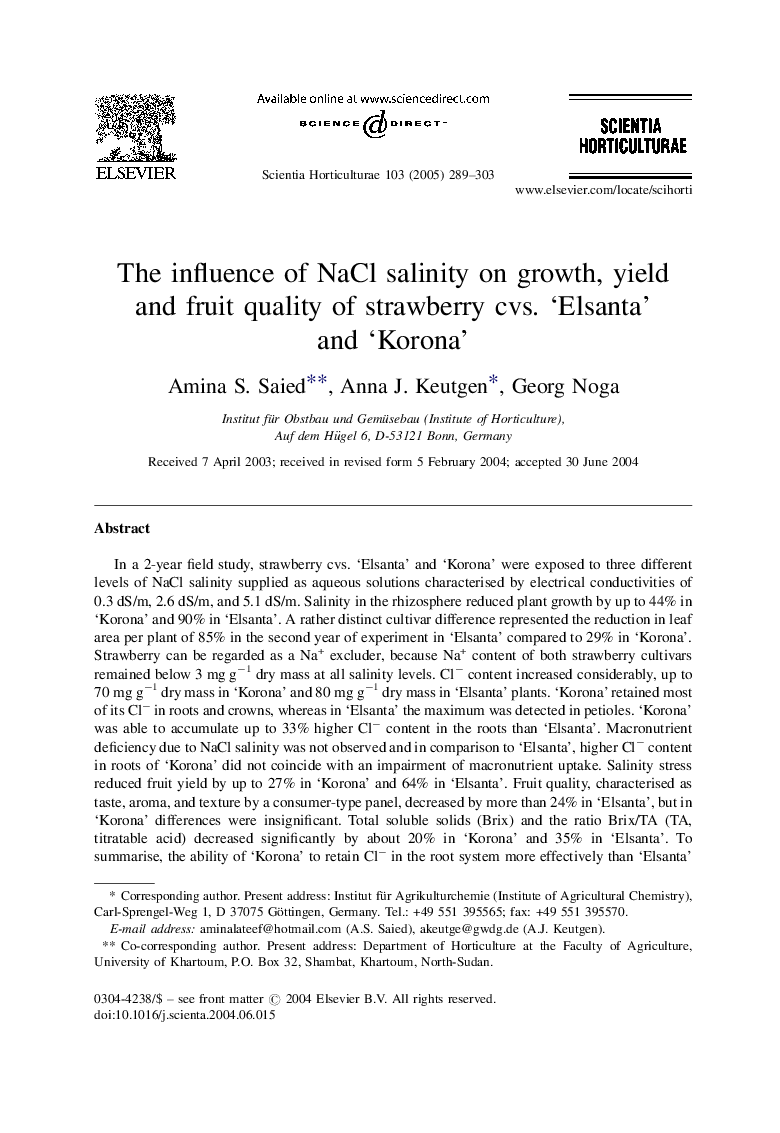| Article ID | Journal | Published Year | Pages | File Type |
|---|---|---|---|---|
| 9488704 | Scientia Horticulturae | 2005 | 15 Pages |
Abstract
In a 2-year field study, strawberry cvs. 'Elsanta' and 'Korona' were exposed to three different levels of NaCl salinity supplied as aqueous solutions characterised by electrical conductivities of 0.3 dS/m, 2.6 dS/m, and 5.1 dS/m. Salinity in the rhizosphere reduced plant growth by up to 44% in 'Korona' and 90% in 'Elsanta'. A rather distinct cultivar difference represented the reduction in leaf area per plant of 85% in the second year of experiment in 'Elsanta' compared to 29% in 'Korona'. Strawberry can be regarded as a Na+ excluder, because Na+ content of both strawberry cultivars remained below 3 mg gâ1 dry mass at all salinity levels. Clâ content increased considerably, up to 70 mg gâ1 dry mass in 'Korona' and 80 mg gâ1 dry mass in 'Elsanta' plants. 'Korona' retained most of its Clâ in roots and crowns, whereas in 'Elsanta' the maximum was detected in petioles. 'Korona' was able to accumulate up to 33% higher Clâ content in the roots than 'Elsanta'. Macronutrient deficiency due to NaCl salinity was not observed and in comparison to 'Elsanta', higher Clâ content in roots of 'Korona' did not coincide with an impairment of macronutrient uptake. Salinity stress reduced fruit yield by up to 27% in 'Korona' and 64% in 'Elsanta'. Fruit quality, characterised as taste, aroma, and texture by a consumer-type panel, decreased by more than 24% in 'Elsanta', but in 'Korona' differences were insignificant. Total soluble solids (Brix) and the ratio Brix/TA (TA, titratable acid) decreased significantly by about 20% in 'Korona' and 35% in 'Elsanta'. To summarise, the ability of 'Korona' to retain Clâ in the root system more effectively than 'Elsanta' resulted not only in a 41% lower leaf Clâ content at the highest salinity level and a better growth under NaCl stress, but also in a relatively higher fruit yield and fruit quality.
Related Topics
Life Sciences
Agricultural and Biological Sciences
Horticulture
Authors
Amina S. Saied, Anna J. Keutgen, Georg Noga,
